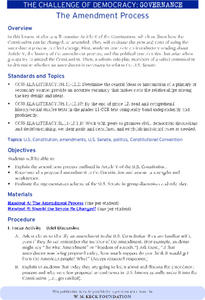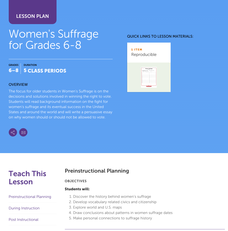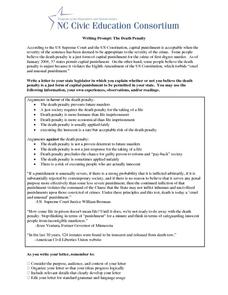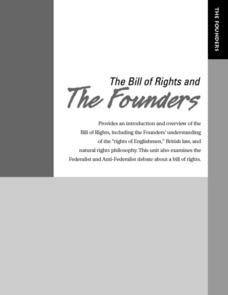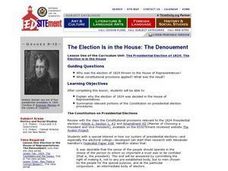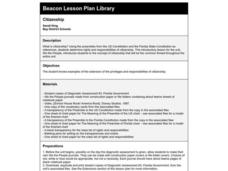Curated OER
The Taliban Meets the Bill of Rights
Pupils contrast the Taliban and the Constitution. They read through "What the Taliban Banned" and identify "rights." They determine if rights in the United States are in danger and if the Taliban violate the first ten amendments to our ...
Curated OER
Representation of the Common Citizen From Declaration of Independence to Present
Students create working definition of common citizen, and investigate and discuss important sections of Declaration of Independence, Articles of Confederation, U.S. Constitution, Bill of Rights, and other Amendments. Students demonstrate...
Administrative Office of the US Courts
Nomination Process
"I do solemnly swear that I will support and defend the Constitution of the United States..." Scholars investigate the nomination process of Supreme Court justices when assuming office. Through examination of primary and secondary...
iCivics
Constitution Day
Celebrate Constitution Day, September 17, with an activity that asks class members to identify the responsibilities of the three branches of the U.S. government.
Constitutional Rights Foundation
The Amendment Process
Long revered as the "upper chamber," the US Senate was created to give the new nation a balance between large and small states. However, has the time for this institution passed? Using a reading on how the amendment process works,...
Curated OER
Civil War and Reconstruction
Factual statements relevant to the Civil War, Reconstruction, slavery, and the 13th, 14th or 15th Amendments are started on each slide, prompting students to complete the sentence with an important term . There are 32 questions phrased...
National Constitution Center
AP English Language—Argument
All things are subject to interpretation ... and that includes the Bill of Rights. Scholars work through activities to analyze and consider various interpretations and perspectives of the rights listed in the Constitution. They complete...
DocsTeach
Lincoln's Suspension of Habeas Corpus During the Civil War
What is the balance between constitutional rights and security during a war? Young historians debate the question while looking at Lincoln's decision to suspect habeas corpus during the Civil War. After reviewing his order, discussion...
Scholastic
Women's Suffrage for Grades 6–8
Learners study the decisions and solutions involved in winning the right to vote. After reading background information on the fight for women's suffrage, including one woman's story, and its eventual success in the United States and...
Friends of Fort McHenry
Privateers in the War of 1812: Soldiers or Thieves?
Do governments have the right to authorize individuals to perform illegal acts during times of war? Did the US government really employ pirates? Use the War of 1812 as your vessel to answering these questions through class discussion and...
National Endowment for the Humanities
“From Time to Time”: Presidents and Communicating with the Public
While the Constitution requires a "State of the Union" address, it doesn't give many details. In fact, it wasn't until Woodrow Wilson that the periodic update to Congress was given in-person. Using primary sources, recordings and...
Carolina K-12
Writing Prompt: The Death Penalty
Is the death penalty unjust because it violates the Eighth Amendment of the United States Constitution, "cruel and unusual punishment"? Or is it just a form of permissible capital punishment? After weighing arguments for and against the...
State Bar of Texas
Marbury v. Madison
Who has the final say in matters dealing with the rules under the United States Constitution? The case Marbury v. Madison brings to light the issue of judicial review. Learners investigate the Supreme Court's opinion in the case with a...
Teaching Tolerance
Using Photographs to Teach Social Justice | Confronting Unjust Laws
The right to peacefully assembly to protest injustice is a key element of the First Amendment to the United States Constitution. Class members are asked to analyze two photographs of people confronting what they consider to be unjust...
Curated OER
What Are Our Common Values?
Students make a poster. In this values lesson, students read the Preamble to the Constitution and discuss the core democratic values that are found there and in the Declaration of Independence. Students are each assigned a core...
Curated OER
Naturalized Citizens and the Presidency
Young scholars consider the presidential requirements. In this U.S. Constitution lesson, students participate in a role play that requires them to act as senators and debate an amendment to allow naturalized citizens to run for the...
Curated OER
The Bill of Rights and the Founders
Students explain similarities between historical statements of rights and their modern applications, explore ideas of "Rights of Englishmen" and natural rights, discuss evolution of concept of rights and its impact on Bill of Rights,...
Curated OER
Scopes Trial Activity
Learners are able to prepare arguments for a moot court case. They know how the Scopes Trial impacts academic freedom today. Students know what constitutional amendments are applicable to this issue (including the Butler Act). They...
Curated OER
How a Bill Becomes a Law
Learners examine Article I, Sections 1, 7, and 8, of the U.S. Constitution and discuss the authority and restrictions placed on the Congress in making laws.
Curated OER
Federalist 47
Students will analyze and evaluate political propaganda. In this lesson on the Federalist movement, students will examine the Federalist papers and analyze the Anti-Federalist argument mage against constitutional ratification. This...
Curated OER
The Election Is in the House: The Denouement
High schoolers research the US Presidential election of 1824. They explain why the election of 1824 was decided in the House of Representatives. They summarize relevant portions of the Constitution on presidential election procedures.
Curated OER
Comparing the 1945 Vietnam Declaration of Independence and Constitution of 1992 with the United States Declaration of Independence and Constitution
Students compare and contrast the Vietnamese and American plans for government. In this government systems lesson, students analyze and compare excerpts of the 1945 Vietnam Declaration of Independence, the Vietnam Constitution of 1992,...
Curated OER
Citizenship
Fifth graders read the preamble of the U.S. and Florida Constitutions. They discuss vocabulary definitions surrounding the concept of citizenship. They discuss and write about the rights and responsibilities of citizens and apply their...
Curated OER
Lesson Plan for Reading
Students in an adult ESL classroom are introduced to the definition of freedom of speech. Using the internet, they discover the differences between the rule of law and rule of men. To end the activity, they examine how the court system...






